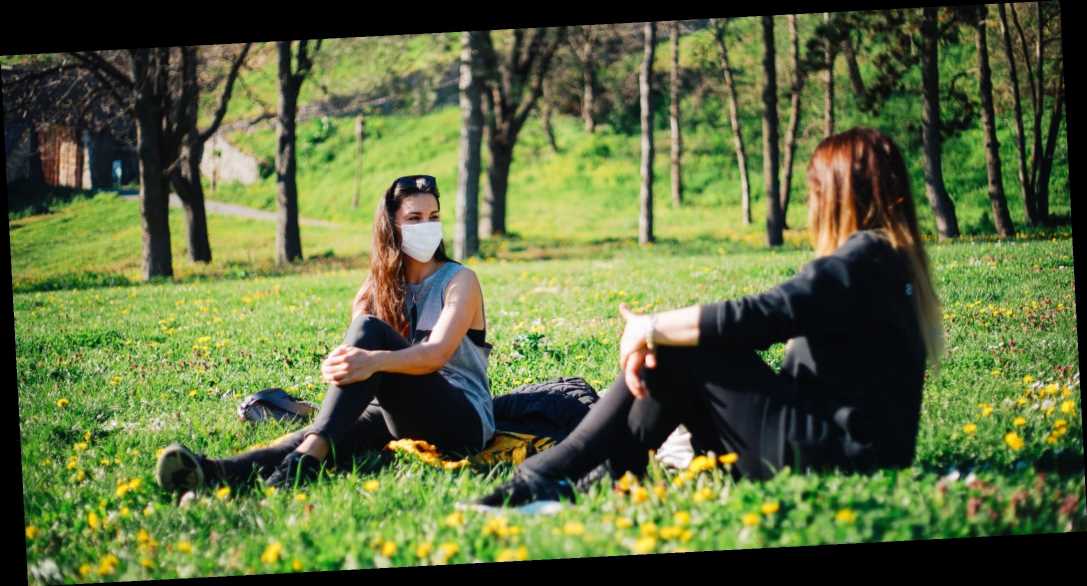- Stay-at-home orders are lifting in many states—but experts stress that seeing friends and family in the ways you may have pre-pandemic is still unsafe.
- Ultimately, your decision to see others depends on your level of risk aversion, although there are steps you can take (like seeing others outdoors) to minimize your odds of spreading COVID-19.
- Elderly people and/or those who are immunocompromised should be most careful and avoid ending their quarantines right now if at all possible.
I’m currently fighting with my mom, and it’s all COVID-19’s fault. When the virus first took hold in my area, my husband and I made the tough decision to not allow anyone—our parents included—into our place. We have three young kids, and it just didn’t make sense to take the risk.
My mom took the news…okay-ish. While she respected our decision, she would make comments about how it was “too hard” when I suggested we all take a social distancing walk together, and she stopped talking to me as much as usual. Also, my sister and her family continued to see my parents on daily basis, so…yeah. That didn’t make it easier for anyone in my family to accept my decision.
Fast-forward to now, and my mom called to ask when she could see the kids again. But in practically the same breath, she mentioned that she had just had my aunt and uncle over for dinner.
I froze. My parents haven’t been as safe as I’d like during this pandemic. They went to the gardening store on a whim, and while they’ve mostly stayed home, they still interacted with other people more than experts have recommended. I almost had a heart attack when my mom suggested hosting an Easter brunch at her place with friends and family. (She did, BTW, and no, I wasn’t there.)
TBH, I probably didn’t handle the next part well. I stumbled over my words and said that I wasn’t quite sure when we’d see them again. It was a total panic-induced word-vomit, sparked by the fact that I just don’t know when I’ll feel comfortable coming into close contact with anyone outside of the family members living in my home.
My mom didn’t take it well, and the conversation ended quickly. It’s been two days, and we haven’t talked since. Despite a few apology texts about the way I handled it (which got zero reply, TYVM), I still have no freaking clue what to do.
I know I’m not the only one going through this. Stay-at-home orders are lifting across the country, but that doesn’t necessarily mean that it’s safe to see family and friends again in the same way you did before the pandemic. Still, if you don’t want to live your life as a germaphobic hermit, what are you supposed to do? I consulted with pros to get some answers.
When is it safe to see friends and family again?
Unfortunately, this isn’t the kind of thing experts can slap a date on. “Because the virus isn’t going to disappear without a vaccine, it’s eventually going to come down to individual risk tolerance and thinking about what is and isn’t essential in your life,” says infectious disease expert Amesh A. Adalja, MD, senior scholar at the Johns Hopkins Center for Health Security. “Until we have a vaccine, no amount of interaction is going to be without risk of transmission.”
Suzanne Willard, PhD, a clinical professor and associate dean for global health at the Rutgers School of Nursing, agrees. “It is all about your idea of what risk is,” she says. “You cannot know what every individual has been doing or where they have been going.”
“It’s not like COVID-19 magically disappeared because politicians decided it’s okay for you to go out.”
In a perfect world, everyone would stay in quarantine until COVID-19 goes away. But in reality, that’s impossible. “It’s not going to be feasible for most people to not see friends and family until we get a vaccine,” Dr. Adalja says. The point of social distancing was to flatten the curve and to attempt to give the medical community time to prepare for COVID-19 patients, he explains. Now that that’s happened in many areas, stay-at-home orders are lifting, but COVID-19 is still out there.
“We’re still going to have to live with this virus until there’s a vaccine,” Dr. Adalja says. “It will come down to a lot of individual choice and trade-off between the spread of the virus and how much living we want to do.”
Once shelter-in-place orders lift, you can ~technically~ start to see friends and family again, “but you ought to be doing it very cautiously,” recommends William Schaffner, MD, an infectious disease specialist and professor at the Vanderbilt University School of Medicine. It’s not like COVID-19 magically disappeared because politicians decided it’s okay for you to go out again, he points out.
That said, if you’re immunocompromised or otherwise at a higher risk of having a severe case of COVID-19, Dr. Schaffner says you probably want to be extra cautious and hold off on coming into close contact with others. “Think twice about seeing other people,” he says.
That’s also true if you happen to have a loved who is at a higher risk. Up to 25 percent of people with COVID-19 have no symptoms, so there’s a chance that you could unknowingly spread the virus to someone else without even realizing it, Dr. Schaffner says.
Basically, there’s no one-size-fits-all approach here. And yeah, it sucks.
Is it safer to see friends and family outside?
Social distancing—to the extent that you can do it—is still important, Dr. Adalja says. “Social distancing denies the virus the ability to move from one person to another because the more people interact with each other, the more likely the virus is to infect someone else. It is the only tool we have against COVID-19 right now,” he says.
So if you’re planning to meet up with people, Dr. Schaffner says it’s not a bad idea to do it outside when possible. That way, you can do your best to maintain social distancing and potentially lower your risk of contracting the virus, he says.
“If you see people outside, the air and breezes actually dilute any potential virus,” he says. That doesn’t mean you can’t get COVID-19 when you’re outside, he adds—your risk just might be a little lower than if someone infected was inside the same space as you, touching and breathing on common surfaces.
But the infectious disease police aren’t going to come after you if you actually have someone over to your place (or go to theirs). “People have to make these choices for themselves,” Dr. Adalja says.
For the record, end-of-quarantine parties are a bad idea.
People have been flooding social media with end-of-quarantine party ideas (and I so get it), but experts say it’s really not a good idea to host or hit up one of these. “Even though there may be an end to stay-at-home orders, the virus is still here,” Dr. Adalja says. “Any kind of mass gathering like a party could be an opportunity for the virus to spread among people.”
Think of it this way: If just one person at the party happens to be infected, the odds are really high that plenty of others—including you—will end up being infected, too. From there, you and everyone else can pass it on to your families, coworkers, and anyone else you come into contact with. And, safety concerns aside, do you really want to be known as the person who hosted the party that got everyone sick?
Should you see elderly relatives?
The Centers for Disease Control and Prevention (CDC) specifically calls out people who are 65 and up, as well as those who live in a nursing home or long-term care facility, as being at high risk of severe illness from COVID-19. People with a variety of other conditions may also fall into high-risk groups—and that risk doesn’t just go away when stay-at-home orders lift.
If you can, Dr. Willard recommends keeping your distance. “Keep in touch by phone or have them set up on video conferencing,” she says.
Of course, that may be impossible if you’re a caregiver for an elderly relative. Again, it ultimately comes down to comfort with everyone’s level of risk.
“Elderly people are going to have to be careful, but it’s still their choice,” Dr. Adalja says. He recommends talking with the elderly person in your life to come up with a plan. Maybe you’ll both wear masks when you interact and you’ll wipe down all surfaces on your way out the door—these are all things you’ll need to figure out together.
Is it safe to have “quarantine buddies”?
If you’ve been diligent about social distancing and you know certain friends and family have, too, it may be safer to stick with this core group as things open up again, Dr. Adalja says.
“These type of arrangements will be safer than just randomly seeing people, but just remember that nothing is going to be risk-free,” he says. It’s also next-to-impossible to know what people in your inner circle are doing to stay safe at times when you’re not around, he points out, so it’s not like there’s zero chance you can get infected this way.
Ultimately, experts stress that you should be as safe as possible while still trying to live your life. “Know that this virus hasn’t gone away,” Dr. Willard says. “These are trying times—unprecedented—and the novelty of stay-at-home has certainly worn away. So, keep a clear head, know that life isn’t what it used to be but that it is life. Be respectful of the gift of being alive.”
Dr. Schaffner stresses the importance of accepting that life isn’t normal anymore. “It’s some semblance of normalcy,” he says. “And, for quite some time, it will be the new normal.”
As for me, I’m not sure what I’m going to do. Two months of #quarantinelife has made me nervous about coming into close contact with anyone, and those feelings don’t just disappear—especially since the virus is still circulating. Hopefully, I can buy a little more time to figure it all out.
Source: Read Full Article



